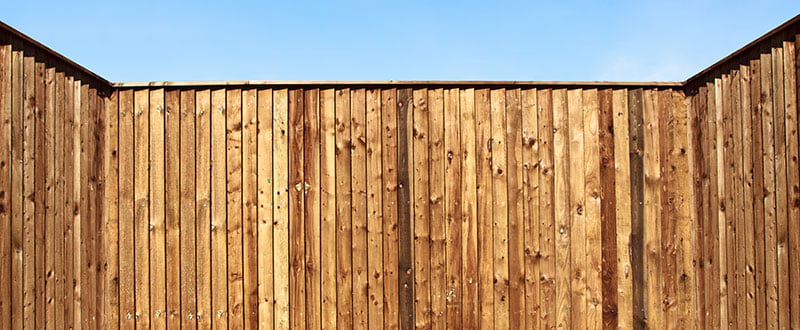
When you’ve taken the time and trouble to enhance your outdoor space with beautiful garden fence panels, it stands to reason that you’ll want them to look at their best for as long as possible. Happily, that’s fairly easy to do – with just a bit of proactive care and attention, you can keep your fence panels looking amazing throughout the year, helping to protect them from the tolls of the most extreme seasonal weather. Here at Welch Fencing, this week we’ll be explaining a few of the best ways on how you can do just that.
Check your garden fence panels regularly
It might sound simple, but you might be surprised at how much time, effort and expense something like this can save you in the long run! It’s a good idea to check your concrete fence posts and timber fence panels regularly for any signs of damage. It doesn’t have to be that often, generally once every couple of months or so. This can help you to easily spot anything before it develops into a more serious or expensive problem which might necessitate you having to replace an entire fence panel.
Keep your garden fence panels clean
Keeping your garden fence panels clean is more than just a matter of their surface appearance – it’s also important because it keeps them clear of mould and rot. Not only will these affect the appearance of your fence, but quite possibly its overall integrity too.
The best way to do this is normally with warm soapy water and a sponge. It might not be the quickest job, but it’s one of the most effective ways to clean your fence while avoiding the chance of too much damage. Just make sure not to completely soak the timber, as this can raise its internal moisture levels, and may even end up actually causing the rot. That’s obviously not the most ideal turn of events!
Can you power wash your fence?
You can, and indeed many people do without incident. However, if you plan to do it that way, you should be extremely careful with the settings. If it’s set on too powerful a setting, you can end up gouging out sections of the wood. That’s the sort of damage that can end up being irreparable. For that reason alone, the sponge and warm water approach might be the safest approach!
Be selective with the oils you use to preserve your fence
It’s not just wet and cold weather which can affect your fence. Over enough years, it’s possible that you may eventually start to notice some fading. Don’t worry about it too much, as it’s easily remedied – you’ll just need a certain type of oil-based preservative, which will preserve the natural colours and grains in the wood. As an extra bonus, they can even help to regulate the internal moisture levels, making your garden fence panels more resistant to damp and rot in the colder and wetter months of the year.
Just make sure to pick a preservative that matches the colour of your fence panels, or the final effect won’t look quite as nice or tidy as you’d want it to. And don’t forget that all this only applies if it’s not a pressure-treated fence. If it is, then you may not need to apply a preservative at all.

Can I apply a preservative to a pressure treated fence?
It’s certainly possible, but if you’re going to do it then you need to be really careful regarding how you go about it. Pressure treated timber has to be left to weather for a fair while before you even think about applying any kind of paint or treatment.
This is because the original treatment can sometimes leave residue, generally noticeable by a distinctive blue or green colour. When that happens, it’s very unlikely that any further treatment or paint will adhere to the residue. In the few instances where it does, that second layer of treatment will come off when the residue does. Again, not ideal!
All that goes some way to explaining why you should wait at least two or three months before applying any kind of further paint or treatment to pressure-treated wood, and if you are doing it, make sure that the coating is recommended for use with pressure-treated wood.
(It’s worth noting that many experts recommend not doing it at all! Once garden fence panels have been pressure-treated in the first place, they shouldn’t need to be pressure-treated again for at least another ten years or so.)
One final tip…
Whatever work you’re carrying out on your garden fence panels, you need to ensure that you’re doing it under the right weather conditions. Ideally these should be dry and moderate – you certainly won’t want to be doing any work to your fence in any extreme conditions. That means it shouldn’t be blazing hot, or blazing cold, and not sleet or snow or driving rain. Let’s be honest, it’s unlikely that you’ll want to be doing much garden work in heavy rain anyway, but it’s still worth saying because if you apply preservative in the rain, you could end up trapping moisture in your garden fence panels, which will ultimately cause the paint to peel away.
Of course, if you do end up requiring any new garden fence panels, or even a new fence entirely, you’re in exactly the right place. Here at Welch Fencing we’ve got a great range of these and concrete fence posts for you to browse right here on our site. As an experienced UK manufacturer of concrete fence posts and garden fence panels, we have our very own fleet of delivery vehicles at our disposal, allowing us to get your products right to your door.
If you have any questions about any of our products, or you need any more detailed information, feel free to contact us on 01772 336 476, or fire us a quick email on [email protected].




